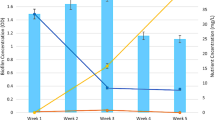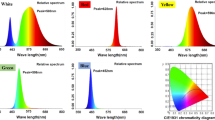Abstract
All physico-chemical parameters that affect bacterial growth rate will also affect bacterial molecular composition, which in turn influences the chemical composition of bacterial lysate and its turnover rate in the ecosystem. To produce qualitatively different lysates, Vibrio sp. cells were grown under different pH, salt, or temperature conditions in rich growth media and then washed and lysed by autoclaving. Both the absolute concentrations and the ratios between elements in the lysates varied with different growth conditions, implying differences in lysate quality. Either Pseudoalteromonas sp. or Vibrio sp. was grown on the lysates at non-limiting lysate concentrations. Different lysates supported growth rates of Pseudoalteromonas sp. in the range from 0.25 to 1.53 h−1. On the other hand, growth rates of Vibrio sp. grown on its own lysates were around 0.4 h−1 and were not dependent on lysate quality. Two orders of magnitude decrease in Zn concentration in Vibrio sp. cells grown on different lysates as compared to cells grown on rich growth medium suggested that Zn might be a factor limiting growth. In the simple microbial loop studied, the initial difference in lysate quality was preserved in Pseudoalteromonas sp., whereas Vibrio sp. decreased the initial differences in lysate quality, thereby neutralizing the primary effect of environmental conditions on carbon turnover.



Similar content being viewed by others
References
Amon RMW, Benner R (1996) Bacterial utilization of different size classes of dissolved organic matter. Limnol Oceanogr 41(1):41–51
Baker TA, Bell SP (1998) Polymerases and the replisome: machines within machines. Cell 92:295–305
Baumann P, Schubert RHW (1984) Vibrionaceae. In: Krieg NR (ed) Bergey’s manual of systematic bacteriology, vol. 1. Williams & Wilkins, Baltimore, pp 516–538
Bhakoo M, Herbert RA (1979) The effects of temperature on the fatty acid composition and phospholipid composition of four obligately psychrophilic Vibrio spp. Arch Microbiol 121:121–127
Botsford JL (1990) Analysis of protein expression in response to osmotic stress in Escherichia coli. FEMS Microbiol Lett 72:355–360
Brown MH, Booth IR (1991) Acidulants and low pH. In: Russell NJ, Gould GW (eds) Food preservatives. Blackie, Glasgow, pp 22–43
Bruins MR, Kapil S, Oehme FW (2000) Microbial resistance to metals in the environment. Ecotox Environ Safe 45:198–207
Danevčič T, Rilfors L, Štrancar J, Lindblom G, Stopar D (2005) Effects of lipid composition on the membrane activity and lipid phase behaviour of Vibrio sp. DSM14379 cells grown at various NaCl concentrations. Biochim Biophys Acta 1712:1–8
Dawson RMC, Elliott WH (1959) Buffers in physiological media. In: Dawson RMC, Elliott DC, Elliott WH, Jones KM (eds) Data for biochemical research. Oxford University Press, Oxford, pp 200–205
Docherty KM, Young KC, Maurice PA, Bridgham SD (2006) Dissolved organic matter concentration and quality influences upon structure and function of freshwater microbial communities. Microb Ecol 52:378–388
Fisher NS, Fabris JG (1982) Complexation of Cu, Zn and Cd by metabolites excreted from marine diatoms. Mar Chem 11(3):245–255
Gnezda-Meijer K, Mahne I, Poljšak-Prijatelj M, Stopar D (2006) Host physiological status determines phage-like particle distribution in the lysate. FEMS Microbiol Ecol 55(1):136–145
Hantke K (2005) Bacterial zinc uptake and regulators. Curr Opin Microbiol 8:196–202
Jones PG, vanBogelen RA, Neidhart FC (1987) Induction of proteins in response to low temperature in Escherichia coli. J Bacteriol 169(5):2092–2095
Kempf B, Bremer E (1998) Uptake and synthesis of compatible solutes as microbial stress responses to high-osmolality environments. Arch Microbiol 170:319–330
Kogut M, Russell NJ (1984) The growth and phospholipid composition of a moderately halophilic bacterium during adaptation to changes in salinity. Curr Microbiol 10:95–98
Leaphart AB, Thompson DK, Huang K, Alm E, Wan X-F, Arkin A, Brown SD, Wu L, Yan T, Liu X, Wickham GS, Zhou J (2006) Transcriptome profiling of Shewanella oneidensis gene expression following exposure to acidic and alkaline pH. J Bacteriol 188(4):1633–1642
Mejía R, Gómez-Eichelman MC, Fernández MS (1999) Fatty acid profile of Escherichia coli during the heat-shock response. Biochem Mol Biol Int 47(5):835–844
Middelboe M, Jørgensen NOG (2006) Viral lysis of bacteria: an important source of dissolved amino acids and cell wall components. J Mar Biol Ass UK 86:605–612
Middelboe M, Jørgensen NOG, Kroer N (1996) Effects of viruses on nutrient turnover and growth efficiency of noninfected marine bacterioplankton. Appl Environ Microbiol 62:1991–1997
Middelboe M, Riemann L, Steward GF, Hansen V, Nybroe O (2003) Virus-induced transfer of organic carbon between marine bacteria in a model community. Aquat Microb Ecol 33:1–10
Nanamiya H, Akanuma G, Natori Y, Murayama R, Kosono S, Kudo T, Kobayashi K, Ogasawara N, Park SM, Ochi K, Kawamura F (2004) Zinc is a key factor in controlling alternation of two types of L31 protein in the Bacillus subtilis ribosome. Mol Microbiol 52:273–283
Noble RT, Fuhrman JA (1999) Breakdown and microbial uptake of marine viruses and other lysis products. Aquat Microb Ecol 20:1–11
Odić D, Turk V, Stopar D (2007) Environmental stress determines quality of bacterial lysate and its utilization efficiency in a simple microbial loop. Microb Ecol 53:639–649
Pérez MT, Sommaruga R (2006) Differential effect of algal- and soil-derived dissolved organic matter on alpine lake bacterial community composition and activity. Limnol Oceanogr 51(6):2257–2537
Phan T-N, Buckner T, Sheng J, Baldeck JD, Marquis RE (2004) Physiological actions of zinc related to inhibition of acid and alkali production by oral streptococci in suspensions and biofilms. Oral Microbiol Immunol 19:31–38
Pomeroy LR, PJleB W, Azam F, Hobbie JE (2007) The microbial loop. Oceanography 20:28–33
Poorvin L, Rinta-Kanto JM, Hutchins DA, Wilhelm SW (2004) Viral release of iron and its availability to marine plankton. Limnol Oceanogr 49(5):1734–1741
Rueter JG, Morel FMM (1981) The interaction between zinc deficiency and copper toxicity as it affects the silicic acid uptake mechanisms in Thalassiosira pseudonana. Limnol Oceanogr 26(1):67–73
Schlesinger MJ (1990) Heat shock proteins. J Biol Chem 265:12111–12114
Schreiber DR, Millero FJ, Gordon AS (1990) Production of an extracellular copper-binding compound by the heterotrophic marine bacterium Vibrio alainolyticus. Mar Chem 28:275–284
Shannon SP, Chrzanowski TH, Grover JP (2007) Prey food quality affects flagellate ingestion rates. Microb Ecol 53:66–73
Sunda WG (1986) Neritic-oceanic trends in trace-metal toxicity to phytoplankton communities. In: Proc 4th Int Ocean Disposal Symp, pp 19–29
Sunda WG, Huntsman SA (1998) Processes regulating cellular metal accumulation and physiological effects: phytoplankton as model systems. Sci Tot Environ 219:165–181
Sundh I (1992) Biochemical composition of dissolved organic carbon derived from phytoplankton and used by heterotrophic bacteria. Appl Environ Microbiol 58(9):2938–2947
Štupar J, Dolinšek F, Simčič J, Bizjak M, Budič B (2005) Trace element analysis of the hair of Duke Mirko Petrovic-Njegos—a possible means of clarification of his death. Trace Elem Electrolytes 22(2):118–126
van den Berg CMG, Merks AGA, Duursma EK (1987) Organic complexation and its control of the dissolved concentrations of copper and zinc in the Scheldt estuary. Estuar Coast Shelf Sci 24(6):785–797
Vrede T, Persson J, Aronsen G (2002) The influence of food quality (P:C ratio) on RNA:DNA ratio and somatic growth rate of Daphnia. Limnol Oceanogr 47(2):487–494
Acknowledgment
This work was supported by the Slovenian Research Agency (ARRS 3311-02-831488).
Author information
Authors and Affiliations
Corresponding author
Rights and permissions
About this article
Cite this article
Odić, D., Budič, B., Mandić-Mulec, I. et al. Influence of Bacterial Lysate Quality on Growth of Two Bacterioplankton Species. Microb Ecol 59, 246–252 (2010). https://doi.org/10.1007/s00248-009-9557-1
Received:
Accepted:
Published:
Issue Date:
DOI: https://doi.org/10.1007/s00248-009-9557-1




